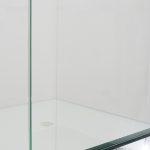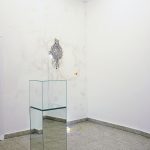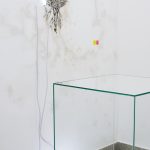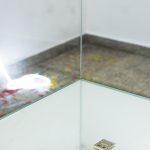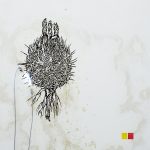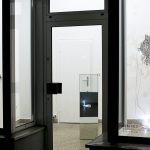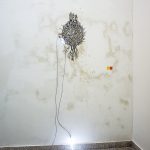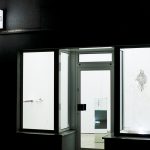ZERO-FOLD
The centre of the installation ZERO-FOLD is a blank space: on the misprint of a Bayern-Einser – one of the first stamps to be issued between 1849 and 1851 – a small unprinted line in the picture remained free due to an accidental folding. From this tiny undefined zero compartment, Andreas Gehlen develops a complex cosmos in the exhibition space with a few key design data, the irregular floor plan of which analogously suggests that it used to be an unspecific free space between two buildings.
The presentation of the brand in a glass display case on an all around mirrored base emphasizes its preciousness, and at the same time makes it completely disappear as an object in space depending on the angle of view. The mistake on the stamp, curved like the creator’s pointer to Michelangelo’s “Creation of Adam” in the Sistine Chapel, is a niche, fold, lap, a place of origin that artists and viewers can occupy in a childlike manner in order to redefine space from there.
In his treatise “The Fold” Gilles Deleuze defines the Baroque as the development from the art of structure, for which the Renaissance stands, to the art of texture.1 Relief-like and plastic elements dissolve the structural fixation of central perspective and allow several levels of perception. The fold, as a transition between the two-dimensional surface and a three-dimensional structure that slips into space, is the basic unit of plastic form generation, and meets as a result of transformation in the scientific models of mathematics, physics, geology, catastrophe theory, the calculation of digital spaces.
The fold is the mediator between painting and relief: Richard Serra lists the word “to fold” as the third verb of his “verb list” of plastic action, Jacques Derrida searches for the French word “pli” in vocabulary of Latin origin: Application.2
The associative correspondences and formal analogies within the flyer and in the exhibition space deal with the basic decisions of the first sculptural settings. Similar to the “zero compartment” in roulette, the installation ZERO-FOLD in the showcase object, the neon sculptures, the cut-out of a plant drawing mounted on the wall and the scales and pictograms on found footage material, outlines a spectrum of meaning that focuses on unfolding and control, order and chaos, growth and antiform.
The folds of the supports and roof of the “Solar Panel” from the “Parc Diagonal Mar” at the port of Barcelona define a blank space. Does the archaeologist water the site of a fireplace from the Neolithic in her photography from the 1970s or does a high priestess tame the uncontrollable will of form in a hotbed of unknown primordial forces in a hero pose?
Two opposing movements dynamise the wall application in the exhibition space: the cut-out, fixed like a stamp with glue, of a cactus plucked out drives, like a grenade, upwards – elevation skywards, crowned by a group of the Holy Trinity. The pictograms of a single and double zero compartment appearing in the brochure, illustrations from a mathematical treatise by Bernhard Riemann on the development of three-dimensional bodies from 1871, slide down the wall and dissolve into an anti-form on the floor: apparently torn off, leaving only a short worm-shaped piece, which in turn can become the root for a new formation of form.
Rolled lots with rivet rust slogans, in the two colours of the following prints of the single-cruiser stamp, ironically citing baroque rollerwork, correspond with the cactus spines that were formed millions of years ago from a rolled sheet.
The visible exterior of each fold, roll holds an invisible interior and again and again: the option.
Birgit Laskowski, Zero Fold, Cologne
